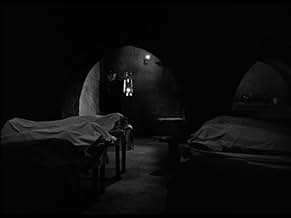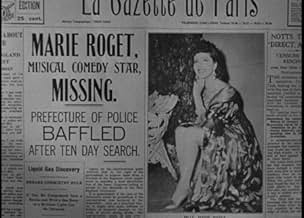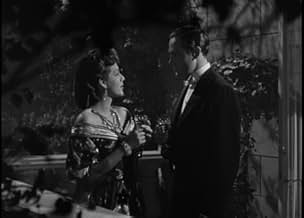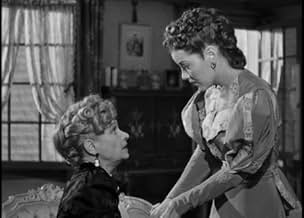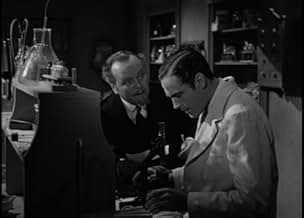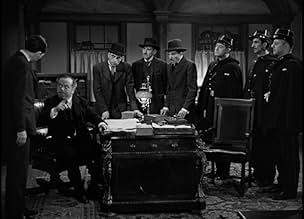Aggiungi una trama nella tua linguaA detective tries to unravel the strange circumstances surrounding the death of a young actress.A detective tries to unravel the strange circumstances surrounding the death of a young actress.A detective tries to unravel the strange circumstances surrounding the death of a young actress.
- Regia
- Sceneggiatura
- Star
Paul E. Burns
- Gardener
- (as Paul Burns)
William Ruhl
- Detective
- (as Bill Ruhl)
Raymond Bailey
- Gendarme
- (non citato nei titoli originali)
Joseph E. Bernard
- Man
- (non citato nei titoli originali)
Paul Bryar
- Detective
- (non citato nei titoli originali)
Caroline Frances Cooke
- Woman
- (non citato nei titoli originali)
Recensioni in evidenza
Edgar Allan Poe's three tales of Paris crime-solver C. Auguste Dupin are considered the first detective stories. "The Mystery of Marie Roget" is the least known of the three, and by far the dullest, but it has the distinction of being the first "ripped from the headlines" whodunit. Based on the unsolved murder of a minor New York celebrity named Mary Rogers, "Marie Roget" was a thinly fictionalized essay on the facts of that case and the newspapers' theories about it. (How thinly fictionalized was it? Poe even added footnotes to remind readers that he was actually talking about Mary Rogers!) There are plenty of colorful theories about why Poe came up with such a vague, confusing solution to the mystery, but he probably just didn't want to be proved wrong if the real crime was ever solved.
Any "Marie Roget" movie true to the original material would attract mostly scholars, literary buffs and insomniacs, but fortunately this film throws in elements from other Poe stories to liven things up. It also has Dupin do something a bit more exciting than sit in an armchair and deliver a lecture. He's called "Paul Dupin" here, but as Marie Roget might say, "Just call me Mary."
Any "Marie Roget" movie true to the original material would attract mostly scholars, literary buffs and insomniacs, but fortunately this film throws in elements from other Poe stories to liven things up. It also has Dupin do something a bit more exciting than sit in an armchair and deliver a lecture. He's called "Paul Dupin" here, but as Marie Roget might say, "Just call me Mary."
This was among the very few remaining vintage Universal Horror titles, a genuine 'B' movie but a surprisingly effective one nonetheless – if only tenuously related to the genre (being based on an Edgar Allan Poe tale, the presence of an ostensibly dangerous animal i.e. a leopard, thus anticipating the Val Lewton chiller THE LEOPARD MAN {1943}, and its utilizing a steel-claw for a murder weapon that literally obliterates the victims' faces
which, apart from the latter film itself, would subsequently see service in at least 2 more of the studio's efforts, namely the Sherlock Holmes adventure THE SCARLET CLAW {1944} and the maligned SHE-WOLF OF London {1946}!).
Incidentally, this can be considered an unofficial sequel to one of the earliest Universal horror classics, MURDERS IN THE RUE MORGUE (1932), since it is not only set in much the same surroundings as that more popular Poe story but it actually features one of the protagonists, forensic expert Pierre Dupin (here played by stiff-upper-lipped but likable Patric Knowles, who around this same time would co-star in two higher-profile genre efforts for the studio in THE WOLF MAN {1941} and its direct successor in the Larry Talbot franchise FRANKENSTEIN MEETS THE WOLF MAN {1943}!). For the record, MYSTERY OF MARIE ROGET managed to rope in another cast member of those very pictures, Maria Ouspenskaya who is at her most outspoken here, constantly belittling Prefect of Police and Knowles' long-suffering sidekick Lloyd Corrigan (who indeed has no easier time with the doctor, in view of the fact that the latter never bothers to fully explain his schemes in entrapping criminals to his understandably flustered superior!).
Which brings us to nominal lead Maria Montez though, given the brevity of her appearance in an already tight 61-minute film, this cannot be deemed a star vehicle for her (as it happens, I currently have 7 of those in my "To Watch" pile!). Anyway, while heavily-accented, she does get to warble a song in French (to the evident delight of Corrigan) and, in any case, her character is established as being wicked which Knowles goes to extreme lengths to prove (by stealthily extracting the brain from her corpse in the morgue – the scene evoking FRANKENSTEIN {1931} in conception and MYSTERY OF THE WAX MUSEUM {1933} in execution – and, under advise from some eminent authority on the workings of the criminal mind, carrying out experiments on it off-screen!).
Despite watching this via a worn-out VHS print, where the detail is so far gone one can hardly discern the actors' facial features(!), the unmistakable atmosphere of a good old Universal horror movie is well in evidence, thus making this a blast (if clearly a minor entry in the field). For what it is worth, we are also treated to a horse-and-carriage chase along the cobbled streets of a studio-built Paris and, while I was sure I had figured out the culprit's true identity, the script (which is surprisingly complex and eminently engaging) went on to prove me wrong by making him out to be the guilty party the Police had fingered all along!
Incidentally, this can be considered an unofficial sequel to one of the earliest Universal horror classics, MURDERS IN THE RUE MORGUE (1932), since it is not only set in much the same surroundings as that more popular Poe story but it actually features one of the protagonists, forensic expert Pierre Dupin (here played by stiff-upper-lipped but likable Patric Knowles, who around this same time would co-star in two higher-profile genre efforts for the studio in THE WOLF MAN {1941} and its direct successor in the Larry Talbot franchise FRANKENSTEIN MEETS THE WOLF MAN {1943}!). For the record, MYSTERY OF MARIE ROGET managed to rope in another cast member of those very pictures, Maria Ouspenskaya who is at her most outspoken here, constantly belittling Prefect of Police and Knowles' long-suffering sidekick Lloyd Corrigan (who indeed has no easier time with the doctor, in view of the fact that the latter never bothers to fully explain his schemes in entrapping criminals to his understandably flustered superior!).
Which brings us to nominal lead Maria Montez though, given the brevity of her appearance in an already tight 61-minute film, this cannot be deemed a star vehicle for her (as it happens, I currently have 7 of those in my "To Watch" pile!). Anyway, while heavily-accented, she does get to warble a song in French (to the evident delight of Corrigan) and, in any case, her character is established as being wicked which Knowles goes to extreme lengths to prove (by stealthily extracting the brain from her corpse in the morgue – the scene evoking FRANKENSTEIN {1931} in conception and MYSTERY OF THE WAX MUSEUM {1933} in execution – and, under advise from some eminent authority on the workings of the criminal mind, carrying out experiments on it off-screen!).
Despite watching this via a worn-out VHS print, where the detail is so far gone one can hardly discern the actors' facial features(!), the unmistakable atmosphere of a good old Universal horror movie is well in evidence, thus making this a blast (if clearly a minor entry in the field). For what it is worth, we are also treated to a horse-and-carriage chase along the cobbled streets of a studio-built Paris and, while I was sure I had figured out the culprit's true identity, the script (which is surprisingly complex and eminently engaging) went on to prove me wrong by making him out to be the guilty party the Police had fingered all along!
This cast of B actors carries off a well-written murder mystery by Edgar Allan Poe. The sister of a woman about to inherit a large fortune plots her murder. But then she herself disappears. Who killed her? Her boyfriend (who was also courting the sister), her grandmother, her estate manager. Or her sister, to protect herself?
The events unfold with a number of false leads and dead ends, and with a few red herrings. However, due to the brilliant detective work of Dr. Dupin, who plays a Sherlock Holmes-type character to the local police chief's Watson-type character. The formula works to a degree, and we have an entertaining mystery.
The events unfold with a number of false leads and dead ends, and with a few red herrings. However, due to the brilliant detective work of Dr. Dupin, who plays a Sherlock Holmes-type character to the local police chief's Watson-type character. The formula works to a degree, and we have an entertaining mystery.
With all due respect to the last person who commented on this movie. I fear what the reviewer does not realize is that Marie Roget is a Poe story. In fact, Poe created the crime story. While I have not seen the movie, I feel it is important to point out that the reviewer claims the movie relies on the 'dumb cop can't figure it out, so he relies on the old smart detective to solve the crime plot' while not realizing that Poe not only created the plot, this main detective Dupin is the genesis of it. Yes, Dupin is the predecessor of Sherlock Holmes. I did notice that some changes were made in the character names, and I do not doubt that the movie is sub par. However, it is important to note that this story and the other two Poe crime stories ares what lead to the great noir films of the 40's
I recently discovered Patrick Knowles and jumped at the chance to see him again here in the Mystery of Marie Roget. The fact that this is a Poe story just made it even more interesting. All of the performances are fine. Prefect Gobelin is a solid foil t Knowles character but he is a bit exasperating at times, but then again I guess he is supposed to be that way. The pace is brisk and moves along nicely and while there are bits of suspense they are unfortunately not very strong. Despite several shortcomings the Mystery of Marie Roget is still worth checking for anyone curious, or for those fans of Patrick Knowles.
Lo sapevi?
- QuizThe original Edgar Allan Poe story is based on the real-life murder of Mary Cecilia Rogers, who was found floating in the Hudson River near Weehawken, NJ. Poe transplanted the events to Paris and placed the case in the hands of amateur detective C. Auguste Dupin. In a weird twist, Poe's ultimate conclusion as to the circumstances of the crime were proved correct when the murderers confessed well after "The Mystery of Marie Roget" was published.
- Citazioni
M. Henri Beauvais: Dupin? You had something to do with those murders in the Rue Morgue didn't you?
Prefect Gobelin: Something to do? Monsieur, Dr. Dupin practicaly solved those murders single handed.
- ConnessioniReferenced in DVD/Lazerdisc/VHS collection 2016 (2016)
- Colonne sonoreMama Dit Moi
(uncredited)
Written by Everett Carter & Milton Rosen
Sung by Dorothy Triden, dubbing Maria Montez
I più visti
Accedi per valutare e creare un elenco di titoli salvati per ottenere consigli personalizzati
Dettagli
- Data di uscita
- Paese di origine
- Sito ufficiale
- Lingua
- Celebre anche come
- Phantom of Paris
- Luoghi delle riprese
- Azienda produttrice
- Vedi altri crediti dell’azienda su IMDbPro
- Tempo di esecuzione1 ora 1 minuto
- Colore
- Proporzioni
- 1.37 : 1
Contribuisci a questa pagina
Suggerisci una modifica o aggiungi i contenuti mancanti

